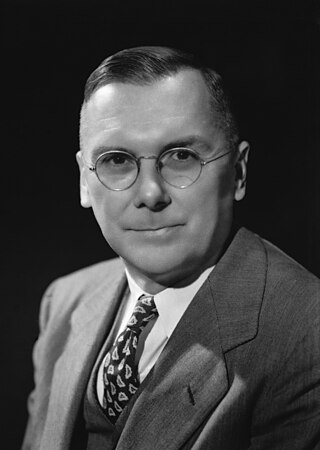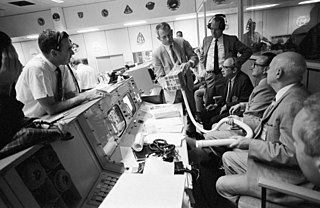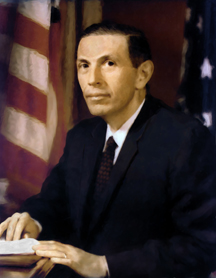Early career
Robert Scanlan was born in Chicago in 1914. He attended the University of Chicago, where he completed a bachelor's and a master's degree in mathematics. The next step in his education was to attend MIT, where he earned a doctorate in mathematics and physics. [3] He was hired as an aeronautical engineer for Republic Aviation in New York, where he served as Chief of Aeroelasticity during World War Two. [1] Following his wartime work, Scanlan was employed by the Federal Aviation Administration, and later became a professor at Rensselaer Polytechnic Institute. During this time, his energy was devoted to research in aeronautics and aeroelasticity, and he published "Aircraft Vibration and Flutter," which is considered to be a fundamental textbook on concepts in elasticity. [1]
Scanlan eventually travelled to France, where he studied at the Sorbonne, completing a doctoral degree in mechanics. While in France, he was employed at CNRS (National Center for Scientific Research) and ONERA (French National Aerospace Research Center). [1]
Later career
After his time in France, Scanlan came back to the U.S. and accepted a job at Schlumberger, a leading oilfield services provider, and later became a member of the faculty at the Case Institute of Technology and Princeton University. [1] Finally, in 1984 he joined the Department of Civil Engineering at Johns Hopkins University, where he stayed until his death. [3] While at the latter two universities, Scanlan began to focus on what became known as wind engineering, and the rest of his career centered on this field. He began working on analyzing the aerodynamics and aeroelasticity of extensive structures like skyscrapers, bridges, and cooling towers. Along with former student Emil Simiu, Scanlan co-authored the book "Wind Effects on Structures," which is considered to be an essential reference concerning the dynamics of structures in response to air currents. [1]
Robert Scanlan died at the age of 86 on May 27, 2001, in Lawrenceville, New Jersey. His death was attributed to heart failure. [3]

Aeroelasticity is the branch of physics and engineering studying the interactions between the inertial, elastic, and aerodynamic forces occurring while an elastic body is exposed to a fluid flow. The study of aeroelasticity may be broadly classified into two fields: static aeroelasticity dealing with the static or steady state response of an elastic body to a fluid flow, and dynamic aeroelasticity dealing with the body's dynamic response.

Theodore von Kármán, was a Hungarian-American mathematician, aerospace engineer, and physicist who worked in aeronautics and astronautics. He was responsible for crucial advances in aerodynamics characterizing supersonic and hypersonic airflow. The human-defined threshold of outer space is named the "Kármán line" in recognition of his work. Kármán is regarded as an outstanding aerodynamic theoretician of the 20th century.

The 1940 Tacoma Narrows Bridge, the first bridge at this location, was a suspension bridge in the U.S. state of Washington that spanned the Tacoma Narrows strait of Puget Sound between Tacoma and the Kitsap Peninsula. It opened to traffic on July 1, 1940, and dramatically collapsed into Puget Sound on November 7 of the same year. The bridge's collapse has been described as "spectacular" and in subsequent decades "has attracted the attention of engineers, physicists, and mathematicians". Throughout its short existence, it was the world's third-longest suspension bridge by main span, behind the Golden Gate Bridge and the George Washington Bridge.

The Office national d'études et de recherches aérospatiales (ONERA) is the French national aerospace research centre. It is a public establishment with industrial and commercial operations, and carries out application-oriented research to support enhanced innovation and competitiveness in the aerospace and defense sectors.

In fluid dynamics, vortex shedding is an oscillating flow that takes place when a fluid such as air or water flows past a bluff body at certain velocities, depending on the size and shape of the body. In this flow, vortices are created at the back of the body and detach periodically from either side of the body forming a Kármán vortex street. The fluid flow past the object creates alternating low-pressure vortices on the downstream side of the object. The object will tend to move toward the low-pressure zone.

Hugh Latimer Dryden was an American aeronautical scientist and civil servant. He served as NASA Deputy Administrator from August 19, 1958, until his death.
Applied mechanics is the branch of science concerned with the motion of any substance that can be experienced or perceived by humans without the help of instruments. In short, when mechanics concepts surpass being theoretical and are applied and executed, general mechanics becomes applied mechanics. It is this stark difference that makes applied mechanics an essential understanding for practical everyday life. It has numerous applications in a wide variety of fields and disciplines, including but not limited to structural engineering, astronomy, oceanography, meteorology, hydraulics, mechanical engineering, aerospace engineering, nanotechnology, structural design, earthquake engineering, fluid dynamics, planetary sciences, and other life sciences. Connecting research between numerous disciplines, applied mechanics plays an important role in both science and engineering.

Albert Irénée Caquot was considered the "best living French engineer" for half of a century. He received the “Croix de Guerre 1914–1918 (France)” and was Grand-croix of the Légion d’Honneur (1951). In 1962, he was awarded the Wilhelm Exner Medal. He was a member of the French Academy of Sciences from 1934 until his death in 1976.

Theodore Theodorsen was a Norwegian-American theoretical aerodynamicist noted for his work at NACA and for his contributions to the study of turbulence.
Ali Hasan Nayfeh was a Palestinian-Jordanian mathematician, mechanical engineer and physicist. He is regarded as the most influential scholar and scientist in the area of applied nonlinear dynamics in mechanics and engineering. He was the inaugural winner of the Thomas K. Caughey Dynamics Award, and was awarded the Benjamin Franklin Medal in mechanical engineering. His pioneering work in nonlinear dynamics has been influential in the construction and maintenance of machines and structures that are common in daily life, such as ships, cranes, bridges, buildings, skyscrapers, jet engines, rocket engines, aircraft and spacecraft.

Aerospace engineering is the primary field of engineering concerned with the development of aircraft and spacecraft. It has two major and overlapping branches: aeronautical engineering and astronautical engineering. Avionics engineering is similar, but deals with the electronics side of aerospace engineering.

Charbel Farhat is the Vivian Church Hoff Professor of Aircraft Structures in the School of Engineering and the inaugural James and Anna Marie Spilker Chair of the Department of Aeronautics and Astronautics, at Stanford University. He is also Professor of Mechanical Engineering, Professor in the Institute for Computational and Mathematical Engineering, and Director of the Stanford-King Abdulaziz City for Science and Technology Center of Excellence for Aeronautics and Astronautics. He currently serves on the Space Technology Industry-Government-University Roundtable.

Alexander Henry Flax was the Chief Scientist of the U.S. Air Force (USAF) from 1959 to 1961, Assistant Secretary of the Air Force for Research and Development from 1963 to 1969, and the third Director of the National Reconnaissance Office (NRO) from 1965 to 1969. He was the director at a time when the second generation of imaging systems became operational and began to play a major role in United States intelligence during the Cold War. He oversaw major growth in NRO funding and personnel, the development of signals intelligence collectors from space, and the development of electro-optical imaging for US reconnaissance satellites.
Holt Ashley was an American aeronautical engineer notable for his seminal research of aeroelasticity.
Arthur Roderick Collar CBE FRS FREng was an English scientist and engineer who made significant contributions in the areas of aeroelasticity, matrix theory and its applications in engineering dynamics.

Nils Otto Myklestad was an American mechanical engineer and engineering professor. An authority on mechanical vibration, he was employed by a number of important US engineering firms and served on the faculty of several major engineering universities. Myklestad made significant contributions to both engineering practice and engineering education, publishing a number of widely influential technical journal papers and textbooks. He also was granted five US patents during his career.

Ahsan Kareem is the Robert M. Moran Professor of Engineering in the Department of Civil & Environmental Engineering and Earth Sciences (CEEES) at the University of Notre Dame. He is Director of the Nathaz Modeling Laboratory and served as the past Chair at the Department of CEEES at the University of Notre Dame.
William Jolly Duncan CBE FRS (1894–1960) was a 20th century Scottish physicist remembered as a pioneer of aeroelasticity and "air flutter" theory critical to modern aviation.
Hans Georg Küssner was a German physicist and aeronautical scientist known for his work in the field of aeroelasticity.

Carlos E. S. Cesnik is a Brazilian-American aerospace engineer, academic, and author. He is the Clarence L. (Kelly) Johnson Collegiate Professor of Aerospace Engineering and the founding Director of the Active Aeroelasticity and Structures Research Laboratory at the University of Michigan. He also directs the Airbus-Michigan Center for Aero-Servo-Elasticity of Very Flexible Aircraft (CASE-VFA).













